fuse TOYOTA RAV4 2006 Service Repair Manual
[x] Cancel search | Manufacturer: TOYOTA, Model Year: 2006, Model line: RAV4, Model: TOYOTA RAV4 2006Pages: 2000, PDF Size: 45.84 MB
Page 64 of 2000

ENGINE - 2AZ-FE ENGINE
Service Tip
To clear the DTC that is stored in the ECM, use a hand-held tester or disconnect the battery terminal
or remove the EFI fuse for 1 minute or longer.
EG-67
Fail-safe
Due to a failure in the battery current sensor or battery temperature sensor, the ECM may determine the
necessity of performing a fail-safe operation. Then, the ECM stops the charging control and the generator
switches to the normal power generation mode.
When the ECM detects a malfunction in a sensor, the ECM memorizes the DTC (Diagnostic Trouble Code).
The MIL (Malfunction Indicator Lamp) does not illuminate.
DTC Chart
DTC No.Detection ItemDTC No.Detection Item
P0516Battery Temperature Sensor
Circuit LowP1551Battery Current Sensor
Circuit Low
P0517Battery Temperature Sensor
Circuit HighP1552Battery Current Sensor
Circuit High
P0560System VoltageP1602Detection of Battery
P1550Battery Current Sensor
Circuit
12. Diagnosis
When the ECM detects a malfunction, the ECM makes a diagnosis and memorizes the failed section.
Furthermore, the MIL in the combination meter illuminates or blinks to inform the driver.
The ECM will also store the DTCs of the malfunctions. The DTCs can be accessed by the use of the
hand-held tester.
For details, refer to the 2006 RAV4 Repair Manual (Pub. No. RM01M1U).
13. Fail-safe
When a malfunction is detected at any of the sensors, there is a possibility of an engine or other malfunction
occurring if the ECM were to continue to control the engine control system in the normal way. To prevent
such a problem, the fail-safe function of the ECM either relies on the data stored in memory to allow the
engine control system to continue operating, or stops the engine if a hazard is anticipated. For details, refer
to the 2006 RAV4 Repair Manual (Pub. No. RM01M1U).
Page 128 of 2000

ENGINE - 2GR-FE ENGINE
Service Tip
The ECM of the ’06 RAV4 uses the CAN protocol for diagnostic communication. Therefore, a
hand-held tester and a dedicated adapter [CAN VIM (Vehicle Interface Module)] are required for
accessing diagnostic data. For details, refer to the 2006 RAV4 Repair Manual (Pub. No.
RM01M1U).
To clear the DTC that is stored in the ECM, use a hand-held tester, and disconnect the battery
terminal or remove the EFI fuse for 1 minute or longer.
EG-132
14. Diagnosis
When the ECM detects a malfunction, the ECM makes a diagnosis and memorizes the failed section.
Furthermore, the MIL (Malfunction Indicator Lamp) in the combination meter illuminates or blinks to
inform the driver.
The ECM will also store the DTCs (Diagnostic Trouble Codes) of the malfunctions. The DTCs can be
accessed by using the hand-held tester.
For details, refer to the 2006 RAV4 Repair Manual (Pub. No. RM01M1U).
Page 240 of 2000
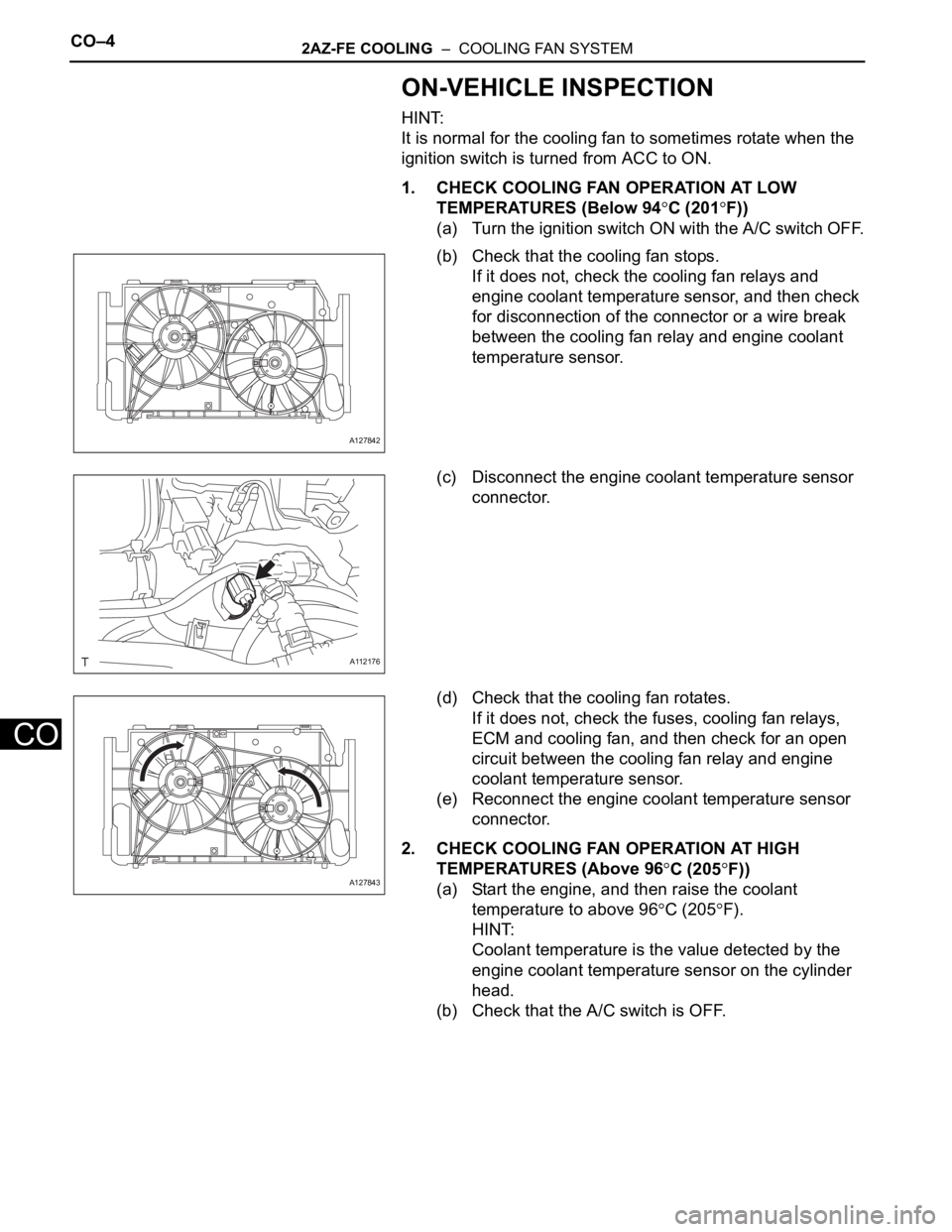
CO–42AZ-FE COOLING – COOLING FAN SYSTEM
CO
ON-VEHICLE INSPECTION
HINT:
It is normal for the cooling fan to sometimes rotate when the
ignition switch is turned from ACC to ON.
1. CHECK COOLING FAN OPERATION AT LOW
TEMPERATURES (Below 94
C (201F))
(a) Turn the ignition switch ON with the A/C switch OFF.
(b) Check that the cooling fan stops.
If it does not, check the cooling fan relays and
engine coolant temperature sensor, and then check
for disconnection of the connector or a wire break
between the cooling fan relay and engine coolant
temperature sensor.
(c) Disconnect the engine coolant temperature sensor
connector.
(d) Check that the cooling fan rotates.
If it does not, check the fuses, cooling fan relays,
ECM and cooling fan, and then check for an open
circuit between the cooling fan relay and engine
coolant temperature sensor.
(e) Reconnect the engine coolant temperature sensor
connector.
2. CHECK COOLING FAN OPERATION AT HIGH
TEMPERATURES (Above 96
C (205F))
(a) Start the engine, and then raise the coolant
temperature to above 96
C (205F).
HINT:
Coolant temperature is the value detected by the
engine coolant temperature sensor on the cylinder
head.
(b) Check that the A/C switch is OFF.
A127842
A112176
A127843
Page 339 of 2000
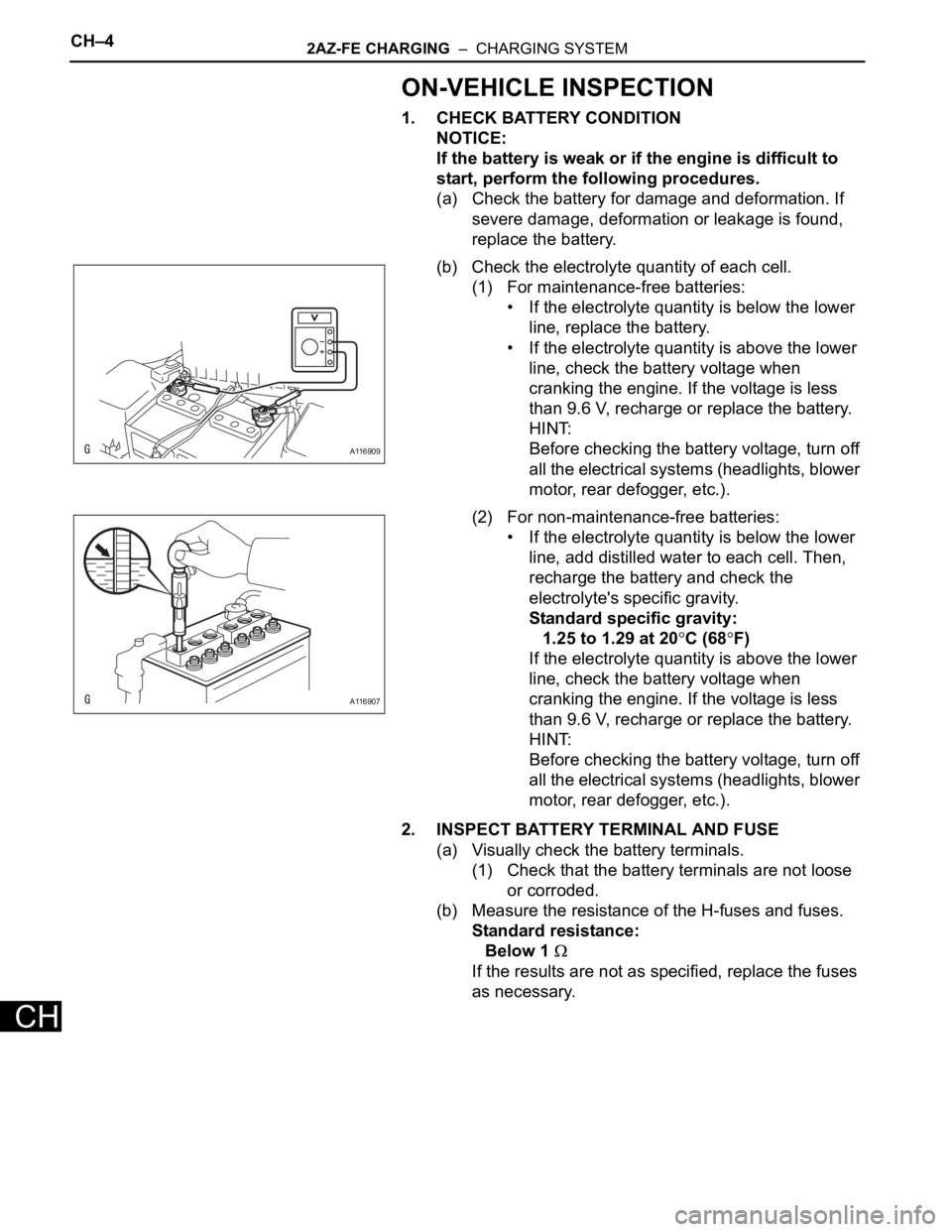
CH–42AZ-FE CHARGING – CHARGING SYSTEM
CH
ON-VEHICLE INSPECTION
1. CHECK BATTERY CONDITION
NOTICE:
If the battery is weak or if the engine is difficult to
start, perform the following procedures.
(a) Check the battery for damage and deformation. If
severe damage, deformation or leakage is found,
replace the battery.
(b) Check the electrolyte quantity of each cell.
(1) For maintenance-free batteries:
• If the electrolyte quantity is below the lower
line, replace the battery.
• If the electrolyte quantity is above the lower
line, check the battery voltage when
cranking the engine. If the voltage is less
than 9.6 V, recharge or replace the battery.
HINT:
Before checking the battery voltage, turn off
all the electrical systems (headlights, blower
motor, rear defogger, etc.).
(2) For non-maintenance-free batteries:
• If the electrolyte quantity is below the lower
line, add distilled water to each cell. Then,
recharge the battery and check the
electrolyte's specific gravity.
Standard specific gravity:
1.25 to 1.29 at 20
C (68F)
If the electrolyte quantity is above the lower
line, check the battery voltage when
cranking the engine. If the voltage is less
than 9.6 V, recharge or replace the battery.
HINT:
Before checking the battery voltage, turn off
all the electrical systems (headlights, blower
motor, rear defogger, etc.).
2. INSPECT BATTERY TERMINAL AND FUSE
(a) Visually check the battery terminals.
(1) Check that the battery terminals are not loose
or corroded.
(b) Measure the resistance of the H-fuses and fuses.
Standard resistance:
Below 1
If the results are not as specified, replace the fuses
as necessary.
A116909
A116907
Page 454 of 2000
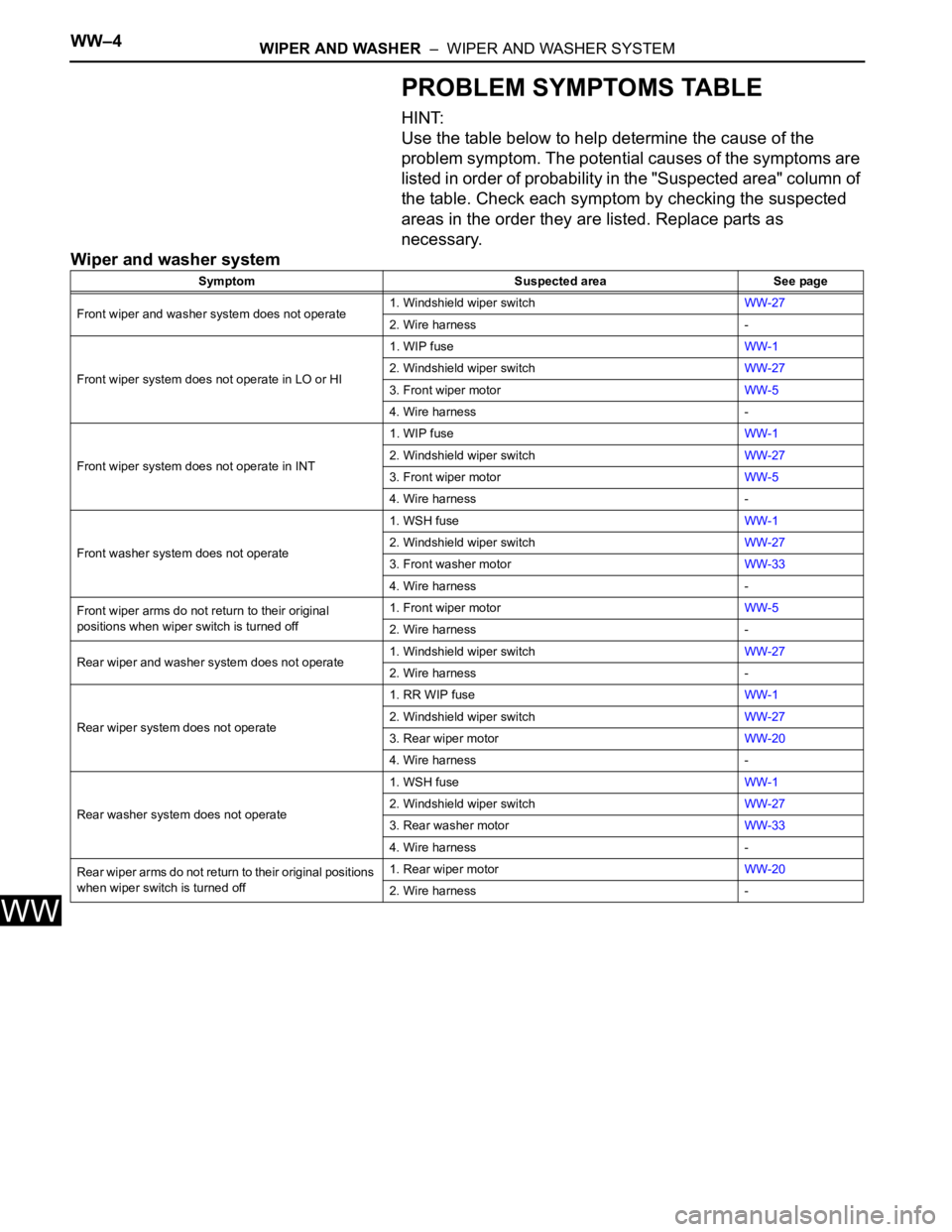
WW–4WIPER AND WASHER – WIPER AND WASHER SYSTEM
WW
PROBLEM SYMPTOMS TABLE
HINT:
Use the table below to help determine the cause of the
problem symptom. The potential causes of the symptoms are
listed in order of probability in the "Suspected area" column of
the table. Check each symptom by checking the suspected
areas in the order they are listed. Replace parts as
necessary.
Wiper and washer system
Symptom Suspected area See page
Front wiper and washer system does not operate1. Windshield wiper switchWW-27
2. Wire harness -
Front wiper system does not operate in LO or HI1. WIP fuseWW-1
2. Windshield wiper switchWW-27
3. Front wiper motorWW-5
4. Wire harness -
Front wiper system does not operate in INT1. WIP fuseWW-1
2. Windshield wiper switchWW-27
3. Front wiper motorWW-5
4. Wire harness -
Front washer system does not operate1. WSH fuseWW-1
2. Windshield wiper switchWW-27
3. Front washer motorWW-33
4. Wire harness -
Front wiper arms do not return to their original
positions when wiper switch is turned off1. Front wiper motorWW-5
2. Wire harness -
Rear wiper and washer system does not operate1. Windshield wiper switchWW-27
2. Wire harness -
Rear wiper system does not operate1. RR WIP fuseWW-1
2. Windshield wiper switchWW-27
3. Rear wiper motorWW-20
4. Wire harness -
Rear washer system does not operate1. WSH fuseWW-1
2. Windshield wiper switchWW-27
3. Rear washer motorWW-33
4. Wire harness -
Rear wiper arms do not return to their original positions
when wiper switch is turned off1. Rear wiper motorWW-20
2. Wire harness -
Page 478 of 2000

ES–242AZ-FE ENGINE CONTROL SYSTEM – SFI SYSTEM
ES
READINESS MONITOR DRIVE
PAT T E R N
1. PURPOSE OF READINESS TESTS
• The On-Board Diagnostic (OBD II) system is designed to
monitor the performance of emission related components,
and indicate any detected abnormalities with DTC
(Diagnostic Trouble Codes). Since various components
need to be monitored during different driving conditions,
the OBD II system is designed to run separate monitoring
programs called Readiness Monitors.
• The intelligent tester's software must be version 9.0 or
newer to view the Readiness Monitor Status. To view the
status, select the following menu items: DIAGNOSIS /
ENHANCED OBD II / MONITOR INFO / MONITOR
STATUS.
• When the Readiness Monitor status reads COMPL
(complete), the necessary conditions have been met for
running the performance tests for that Readiness Monitor.
• A generic OBD II scan tool can also be used to view the
Readiness Monitor status.
HINT:
Many state Inspection and Maintenance (I/M) programs
require a vehicle's Readiness Monitor status to show COMPL
before beginning emission tests.
The Readiness Monitor will be reset to INCMPL (incomplete)
if:
• The ECM has lost battery power or blown a fuse.
• DTCs have been cleared.
• The conditions for running the Readiness Monitor have not
been met.
If the Readiness Monitor status shows INCMPL, follow the
appropriate Readiness Monitor Drive Pattern to change the
status to COMPL.
CAUTION:
Strictly observe posted speed limits, traffic laws, and
road conditions when performing these drive patterns.
NOTICE:
These drive patterns represent the fastest method of
satisfying all conditions necessary to achieve complete
status for each specific Readiness Monitor.
In the event of a drive pattern being interrupted (possibly
due to factors such as traffic conditions), the drive
pattern can be resumed. In most cases, the Readiness
Monitor will still achieve complete status upon
completion of the drive pattern.
To ensure completion of the Readiness Monitors, avoid
sudden changes in vehicle load and speed (driving up
and down hills and/or sudden acceleration).
Page 495 of 2000
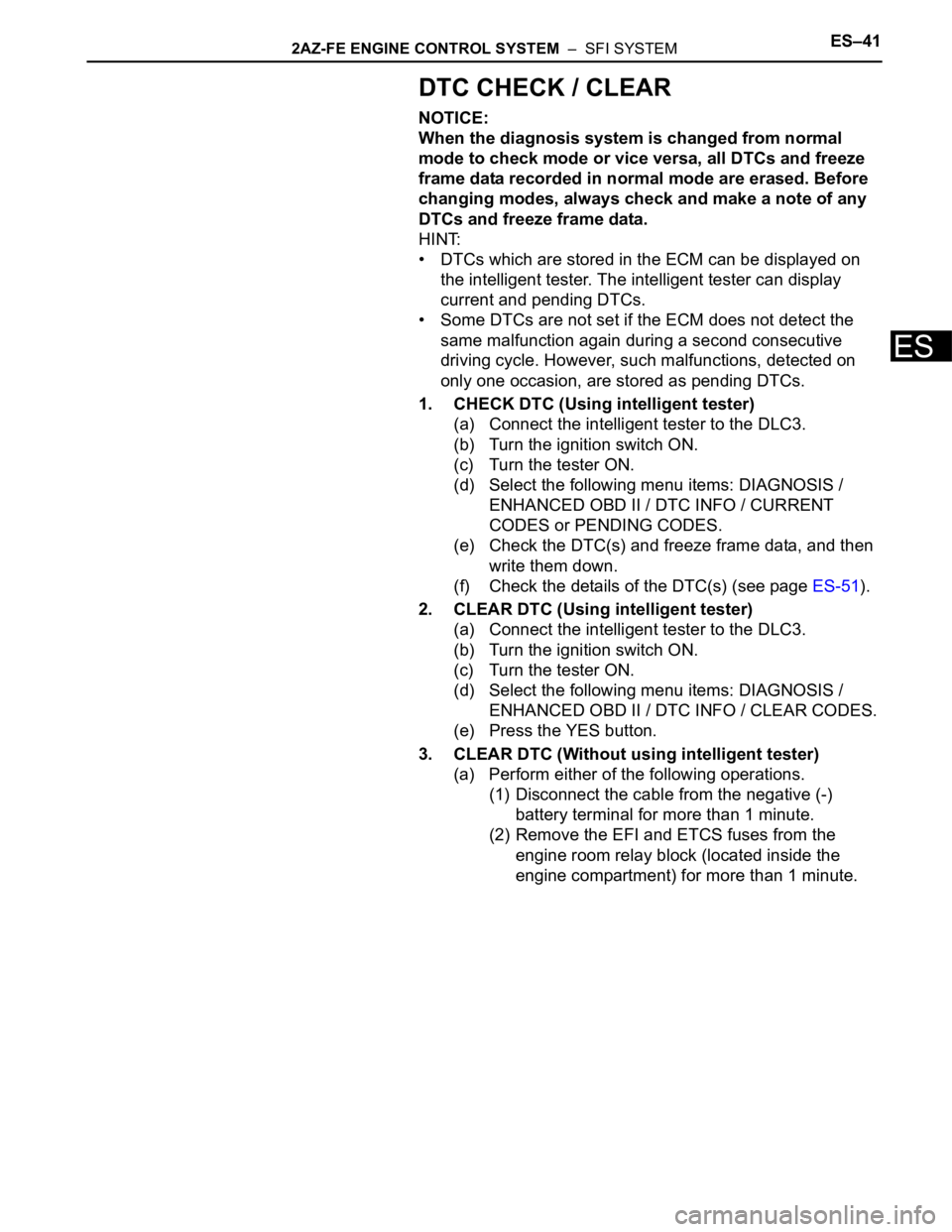
2AZ-FE ENGINE CONTROL SYSTEM – SFI SYSTEMES–41
ES
DTC CHECK / CLEAR
NOTICE:
When the diagnosis system is changed from normal
mode to check mode or vice versa, all DTCs and freeze
frame data recorded in normal mode are erased. Before
changing modes, always check and make a note of any
DTCs and freeze frame data.
HINT:
• DTCs which are stored in the ECM can be displayed on
the intelligent tester. The intelligent tester can display
current and pending DTCs.
• Some DTCs are not set if the ECM does not detect the
same malfunction again during a second consecutive
driving cycle. However, such malfunctions, detected on
only one occasion, are stored as pending DTCs.
1. CHECK DTC (Using intelligent tester)
(a) Connect the intelligent tester to the DLC3.
(b) Turn the ignition switch ON.
(c) Turn the tester ON.
(d) Select the following menu items: DIAGNOSIS /
ENHANCED OBD II / DTC INFO / CURRENT
CODES or PENDING CODES.
(e) Check the DTC(s) and freeze frame data, and then
write them down.
(f) Check the details of the DTC(s) (see page ES-51).
2. CLEAR DTC (Using intelligent tester)
(a) Connect the intelligent tester to the DLC3.
(b) Turn the ignition switch ON.
(c) Turn the tester ON.
(d) Select the following menu items: DIAGNOSIS /
ENHANCED OBD II / DTC INFO / CLEAR CODES.
(e) Press the YES button.
3. CLEAR DTC (Without using intelligent tester)
(a) Perform either of the following operations.
(1) Disconnect the cable from the negative (-)
battery terminal for more than 1 minute.
(2) Remove the EFI and ETCS fuses from the
engine room relay block (located inside the
engine compartment) for more than 1 minute.
Page 501 of 2000
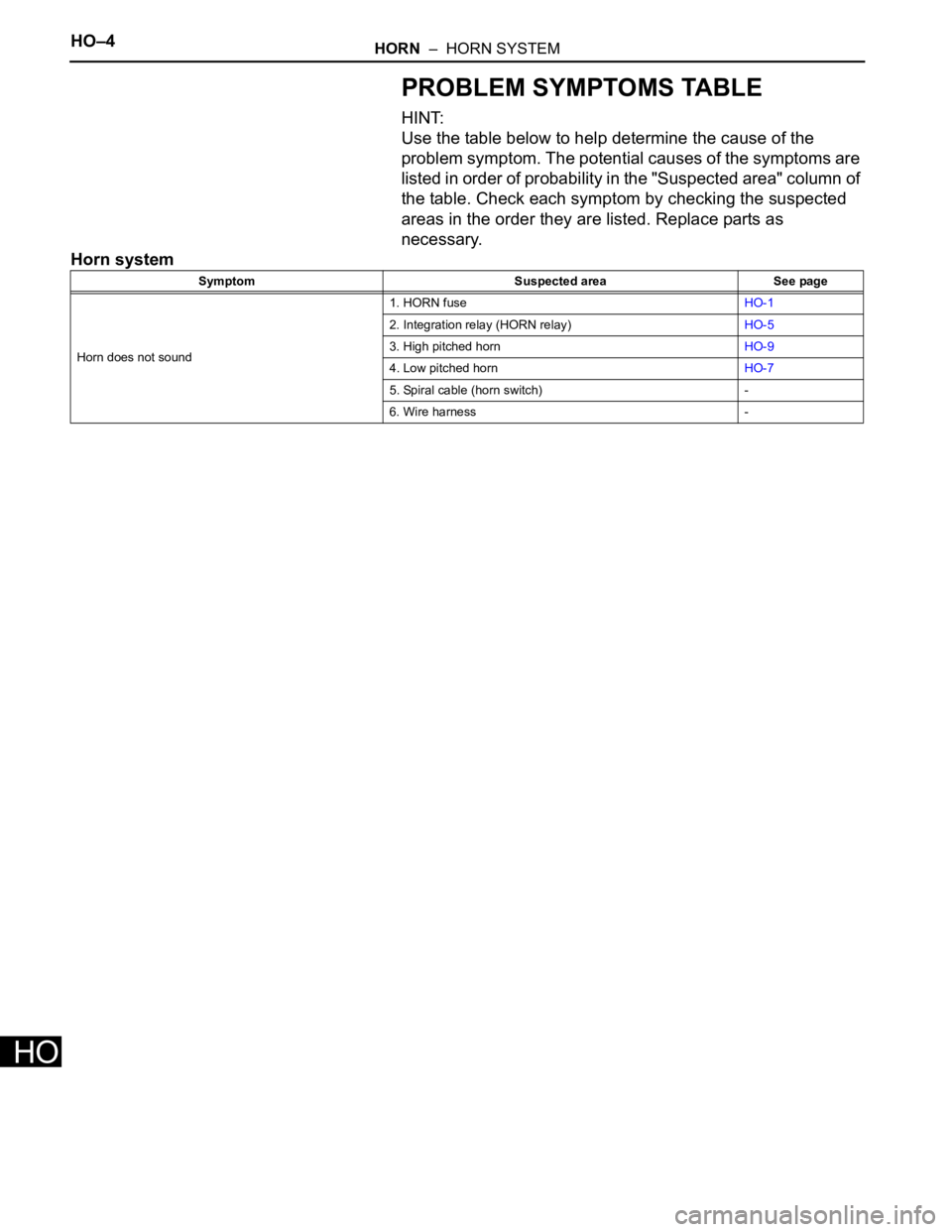
HO–4HORN – HORN SYSTEM
HO
PROBLEM SYMPTOMS TABLE
HINT:
Use the table below to help determine the cause of the
problem symptom. The potential causes of the symptoms are
listed in order of probability in the "Suspected area" column of
the table. Check each symptom by checking the suspected
areas in the order they are listed. Replace parts as
necessary.
Horn system
Symptom Suspected area See page
Horn does not sound1. HORN fuseHO-1
2. Integration relay (HORN relay)HO-5
3. High pitched hornHO-9
4. Low pitched hornHO-7
5. Spiral cable (horn switch) -
6. Wire harness -
Page 504 of 2000

MI–4MIRROR – POWER MIRROR CONTROL SYSTEM
MI
PROBLEM SYMPTOMS TABLE
HINT:
Use the table below to help determine the cause of the
problem symptom. The potential causes of the symptoms are
listed in order of probability in the "Suspected area" column of
the table. Check each symptom by checking the suspected
areas in the order they are listed. Replace parts as
necessary.
Power mirror control system
Symptom Suspected area See page
Mirror does not operate1. ACC fuseMI-1
2. Outer mirror switchMI-13
3. Outer rear view mirrorMI-10
4. Wire harness -
Mirror operates abnormally1. Outer mirror switchMI-13
2. Outer rear view mirrorMI-10
3. Wire harness -
Page 508 of 2000
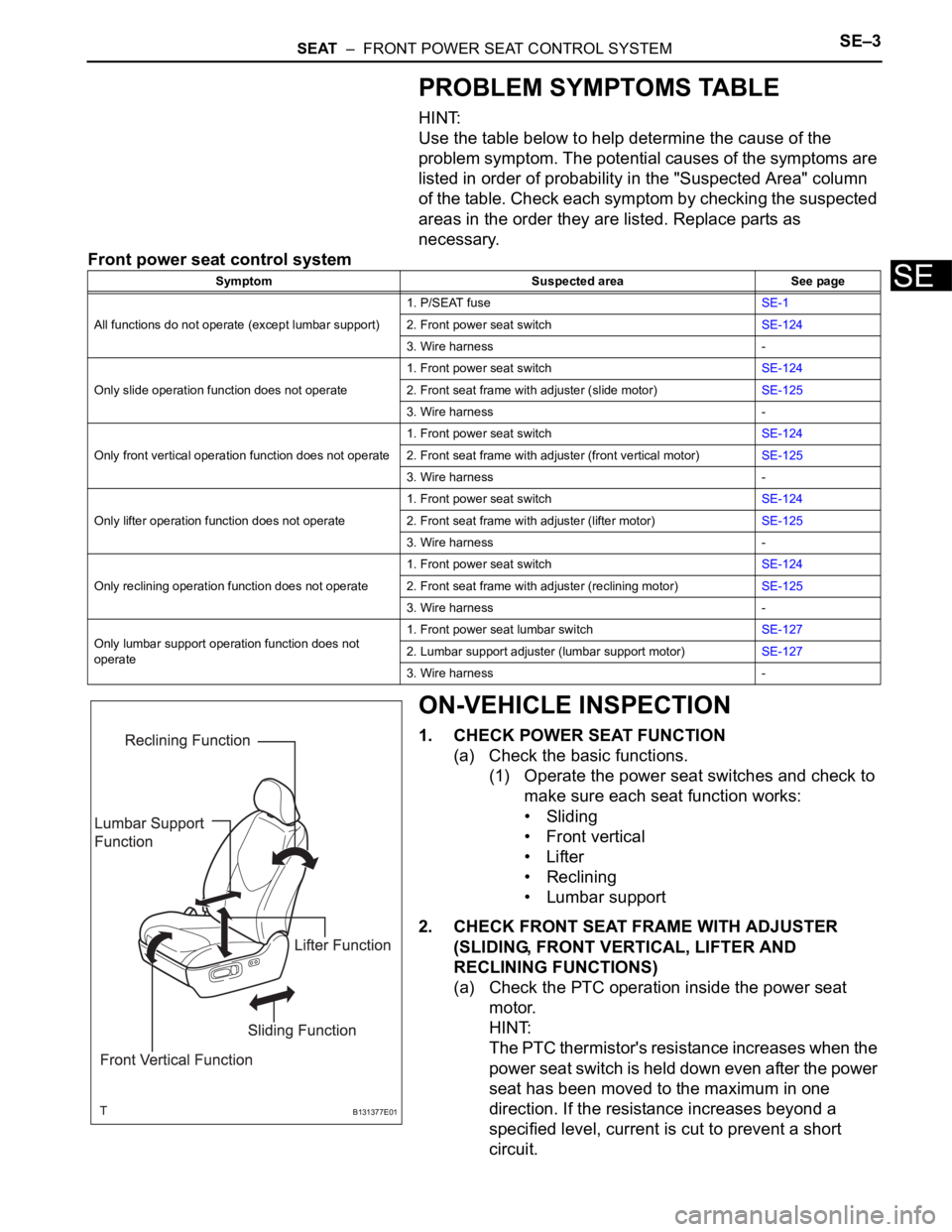
SEAT – FRONT POWER SEAT CONTROL SYSTEMSE–3
SE
PROBLEM SYMPTOMS TABLE
HINT:
Use the table below to help determine the cause of the
problem symptom. The potential causes of the symptoms are
listed in order of probability in the "Suspected Area" column
of the table. Check each symptom by checking the suspected
areas in the order they are listed. Replace parts as
necessary.
Front power seat control system
ON-VEHICLE INSPECTION
1. CHECK POWER SEAT FUNCTION
(a) Check the basic functions.
(1) Operate the power seat switches and check to
make sure each seat function works:
• Sliding
•Front vertical
•Lifter
• Reclining
• Lumbar support
2. CHECK FRONT SEAT FRAME WITH ADJUSTER
(SLIDING, FRONT VERTICAL, LIFTER AND
RECLINING FUNCTIONS)
(a) Check the PTC operation inside the power seat
motor.
HINT:
The PTC thermistor's resistance increases when the
power seat switch is held down even after the power
seat has been moved to the maximum in one
direction. If the resistance increases beyond a
specified level, current is cut to prevent a short
circuit.
Symptom Suspected area See page
All functions do not operate (except lumbar support)1. P/SEAT fuseSE-1
2. Front power seat switchSE-124
3. Wire harness -
Only slide operation function does not operate1. Front power seat switchSE-124
2. Front seat frame with adjuster (slide motor)SE-125
3. Wire harness -
Only front vertical operation function does not operate1. Front power seat switchSE-124
2. Front seat frame with adjuster (front vertical motor)SE-125
3. Wire harness -
Only lifter operation function does not operate1. Front power seat switchSE-124
2. Front seat frame with adjuster (lifter motor)SE-125
3. Wire harness -
Only reclining operation function does not operate1. Front power seat switchSE-124
2. Front seat frame with adjuster (reclining motor)SE-125
3. Wire harness -
Only lumbar support operation function does not
operate1. Front power seat lumbar switchSE-127
2. Lumbar support adjuster (lumbar support motor)SE-127
3. Wire harness -
B131377E01